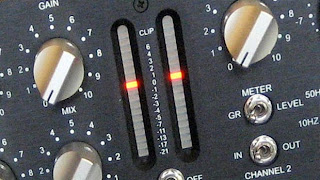
There's nothing like compression for improving a mix. On the other hand, there's nothing like compression for ruining a mix. So when should you compress? And, more importantly, why?
We receive a lot of home studio-produced recordings here at RecordProducer.com and Audio Masterclass. Often I am amazed at the professionalism of what I hear. And sometimes astounded.
But on many occasions I am dismayed. Not because the person responsible hasn't tried hard to make a good mix, but because their mix is ruined by too much compression, of the individual tracks and/or the mix as a whole.
If I had to explain the cause of this problem, I think it all boils down to the 'I've got a fuzzbox and I'm going to use it' syndrome. Except these days it's a compression plug-in. Or worse - a whole suite of plug-ins.
So to get down to business, here is...
The first rule of compression
The first rule of compression is 'Don't!'
Yes that's right, don't compress. With modern equipment there is never any technical need to compress, so there is absolutely no reason why compression should be the norm. Theremust be a good solid justification for you to reach for your plug-in drop-down menu.
But there are two very good reasons why you might want to compress. So...
Reason No. 1 for compression
Reason No. 1 for compression is that you have an instrument or vocal track that varies too much in level. You want to even the level out either because it sounds better with less dynamic range, or simply to make the task of mixing simpler.
But you need to bear in mind that reducing dynamic range with compression is the 'easy way out'. Often this can be done much better through fader-riding and automation. You can home in on every note if necessary and set exactly the right level manually, with no compressor involved.
The benefit of this is that you can apply all of your skill, experience and brainpower to this task. Your compression plug-in has no brain and ploughs through the task with inevitably inferior results.
Controlling dynamic range manually is absolutely the right thing to do for a lead vocal. For the tambourine track, well your compressor will do the job instantly and no-one is going to notice any difference. Apply your time and energy appropriately and don't wear yourself out on trivial matters.
Reason No. 2 for compression
Reason No. 2 for compression is that compression often just sounds nice, regardless of dynamic range issues. And if it sounds nice, then do it!
Compression almost always makes a lead vocal subjectively more pleasant and interesting to listen to, so it is nearly always worth trying out on a lead vocal track. Take your time - try out several plug-ins and experiment with the settings. Don't just use the 'lead vocal' preset. You have taken on the role of mix engineer so do your job and engineer the mix.
It would be surprising if you couldn't get a better lead vocal sound with compression. But if you have tried out all the options and can't make any improvements, well the track just doesn't need compression. (Bear in mind that you need to consider compression in the context of the whole mix, not just on individual tracks in isolation.)
Compression can work nicely on other vocals and instruments too. One instrument that it doesn't do much for however is heavily distorted electric guitar. The distortion effect already creates compression, so there isn't much of a dynamic range for a compression plug-in to work on. But you can try it. Why not?
The magic button of the compressor
Finally, all compressors have a 'magic button'. Did you know that? Well, at least all modern compressors that I can think of. This button is more important than any other control that any hardware or plug-in compressor possesses. And this button is labeled...
'Bypass'
Yes, by pushing this button, you can switch the compressor completely out of circuit!
And why would you want to do that? Well the answer is simple - so that you can hear whether what you are doing is making an improvement. The bypass button should be the most-used control of the compressor*. And if you're not using it, then you don't really know whether you are making things better, or making things worse.
So in conclusion, happy compressing. If you can put your hand on your heart and say every time exactly why you are compressing, then you're well on the road to pro-standard mixing.
*To get the best out of the bypass button, you should set your gain make-up control so that the signal you are compressing sounds subjectively equally loud whether the bypass is switched in or out. Otherwise the change in level when you press the button will cloud your judgment.
No comments:
Post a Comment